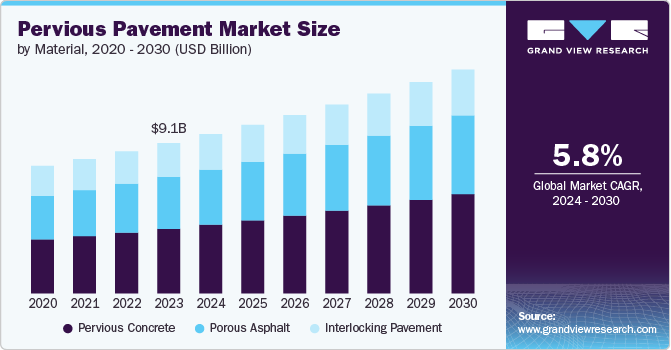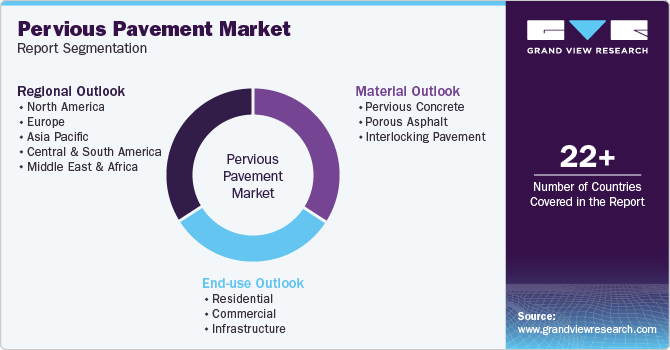
Pervious Pavement Market Size, Share & Trends Analysis Report By Material (Pervious Concrete, Porous Asphalt, Interlocking Pavement), By End-use (Residential, Commercial, Infrastructure), By Region, And Segment Forecasts, 2024 - 2030
- Report ID: GVR-4-68040-427-1
- Number of Report Pages: 100
- Format: PDF
- Historical Range: 2018 - 2022
- Forecast Period: 2024 - 2030
- Industry: Advanced Materials
Pervious Pavement Market Size & Trends
The global pervious pavement market size was estimated at USD 9.13 billion in 2023 and is projected to grow at a CAGR of 5.8% from 2024 to 2030. Pervious concrete allows rainwater to percolate through the pavement and into the ground, reducing surface runoff and recharging groundwater levels. This helps mitigate the urban heat island effect and reduces the risk of flooding in densely built-up areas. The ability to manage stormwater naturally and effectively makes pervious concrete an attractive option for eco-conscious urban planners and developers

Governments and regulatory bodies worldwide are increasingly enforcing stringent regulations on stormwater management to combat the adverse effects of urbanization and climate change. Many regions have implemented policies that require new developments to incorporate sustainable drainage systems (SuDS). Pervious pavement are an effective way to meet these regulations, as they provide a built-in solution for managing stormwater runoff and improving water quality by filtering pollutants.
Rapid urbanization and the expansion of metropolitan areas have heightened the need for effective and sustainable infrastructure solutions. Pervious pavement are becoming popular in urban development projects, including residential areas, commercial complexes, and public spaces. They are particularly valued in urban settings where traditional drainage systems are often overburdened. The ability of pervious pavers to reduce runoff and support groundwater recharge makes them an ideal choice for sustainable urban planning. Furthermore, their application in creating cooler, more comfortable outdoor spaces enhances the quality of urban life.
Although the initial installation cost of pervious pavement can be higher than traditional materials, their long-term economic benefits are substantial. These pavers reduce the need for extensive stormwater infrastructure, such as retention ponds and underground drainage systems, leading to significant cost savings. Additionally, they help prevent flooding and water damage, which can result in considerable savings on repairs and insurance premiums. Over time, the durability and low maintenance requirements of pervious pavement make them a cost-effective solution for municipalities and property developers.
Material Insights
The pervious concrete led the industry with the largest revenue share of 43.0% in 2023 and is forecasted to grow at a significant CAGR from 2024 to 2030. Pervious concrete is uniquely structured to allow water to pass through its surface, promoting groundwater recharge and reducing surface runoff. This characteristic addresses critical environmental concerns such as urban flooding, erosion, and water pollution. Traditional concrete creates impermeable surfaces that exacerbate these issues, but pervious concrete helps manage stormwater naturally. This makes it an integral component in sustainable urban planning and green infrastructure initiatives, which are becoming increasingly important as cities strive to mitigate the impacts of climate change.
Moreover, advancements in materials science and engineering have significantly improved the performance and durability of pervious concrete. Innovations in mix designs and binder materials have enhanced its load-bearing capacity and longevity, making it suitable for a wider range of applications, including high-traffic areas. These technological improvements have also made pervious concrete more reliable and easier to install, further driving its adoption in the market.
Furthermore, growing awareness of environmental issues among consumers and businesses is also contributing to the increased demand for pervious concrete. As more stakeholders recognize the importance of sustainable practices, there is a shift towards using materials that support ecological balance and reduce environmental footprints. This trend is bolstered by the increasing number of green certification programs and the global push towards sustainable development goals, all of which promote the use of eco-friendly materials like pervious concrete
End-use Insights
The infrastructural segment dominated the pervious pavement market in 2023 with a revenue share of 45.1%. One of the significant drivers is the rapid pace of urbanization and infrastructure development globally. As cities expand, there is an increasing need for sustainable and efficient infrastructure solutions. Pervious concrete is particularly well-suited for urban environments where traditional drainage systems can be overwhelmed by stormwater runoff. Its ability to allow water to percolate through its surface helps in managing stormwater effectively, reducing the risk of flooding, and mitigating urban heat island effects. This makes it an essential material for infrastructural structures such as roads, parking lots, sidewalks, and other public infrastructure projects.

Moreover, the long-term economic benefits of using pervious concrete in infrastructure projects also contribute to its large market share. While the initial costs of installation may be higher than traditional concrete, the savings on stormwater management infrastructure, such as retention ponds and underground drainage systems, are substantial. Moreover, the reduced risk of flooding and water damage can lead to lower maintenance and repair costs over time. These economic advantages make pervious concrete a cost-effective solution for municipalities and developers looking to build resilient infrastructure.
Pervious concrete enhances the aesthetics and functionality of urban infrastructure. Its porous nature allows for cooler surfaces compared to traditional concrete, making public spaces like walkways and plazas more comfortable for pedestrians. Additionally, pervious concrete can be designed in various colors and patterns, offering flexibility for urban planners and architects to create visually appealing and functional public spaces. This aesthetic versatility is expected to further drive its adoption in infrastructural projects over coming years.
Regional Insights
With increasing awareness of environmental sustainability, pervious pavement are favored for their ability to recharge groundwater tables and reduce the heat island effect in urban areas. They contribute positively to LEED (Leadership in Energy and Environmental Design) certification requirements, which incentivizes their use in construction projects. As cities expand and undergo redevelopment, there's a growing emphasis on integrating green infrastructure solutions. Pervious pavement are part of sustainable urban planning efforts aimed at improving water quality and overall environmental health.
U.S. Pervious Pavement Market Trends
There are stringent regulatory environment in the U.S. concerning stormwater management. Pervious pavement help in reducing stormwater runoff by allowing water to infiltrate through the pavement surface into the ground, thus minimizing erosion and flooding risks, and further promoting adoption of this product in the industry.
Europe Pervious Pavement Market Trends
The countries in Europe also have stringent regulations regarding water management and pollution control. Pervious pavement assist in complying with these regulations by allowing for natural infiltration and filtration of rainwater, thereby reducing the burden on drainage systems. This is expected to boost industry demand for pervious pavement in this region over coming years.
Asia Pacific Pervious Pavement Market Trends
Asia Pacific region dominated global pervious pavement with the highest revenue share of 36.1% in 2023 and is forecasted to grow at a highest CAGR of 6.4% from 2024 to 2030. Several countries in the Asia-Pacific region face challenges related to water scarcity and rapid urbanization. Pervious pavement are recognized for their potential to alleviate urban flooding and enhance water conservation efforts by facilitating groundwater recharge, increasing product adoption in the market.
Key Pervious Pavement Company Insights
Some of the key players operating in the market include Airlite Plastics Company & TRUEGRID® Pavers and Hübner-Lee GmbH & Co. KG
-
Airlite Plastics Company & TRUEGRID® Pavers is involved in finding environmentally friendly paving alternative to concrete and asphalt. This company operates throughout 50 states in the U.S.
-
Hübner-Lee GmbH & Co. KG caters to several industries including outdoor installations, horticulture, artificial turf pitches, equestrian sports & animal husbandry. This company provides services to several applications including parking spaces, fire department access road, service road, logistics and storage areas, floating root bridge, event areas automobile lots and footpaths & bicycle lanes
Stepstone LLC is one of the emerging market participants.
-
Stepstone LLC is involved in the production of Precast Pavement, Wall Caps, Stair Treads and Pool Coping for several industries. This company works with architects, designers and general contractors.
Key Pervious Pavement Companies:
The following are the leading companies in the pervious pavement market. These companies collectively hold the largest market share and dictate industry trends.
- Airlite Plastics Company & TRUEGRID® Pavers.
- UNI-GROUP U.S.A., INC
- Hengestone Holdings, Inc.
- Hübner-Lee GmbH & Co. KG
- Stepstone, LLC
- Beeson Pervious Concrete
- Vodaland
- Percoa USA LLC
Recent Developments
-
In 2019, Airlite Plastics Co acquired TRUEGRID to be an important part of their Airlite Sustainable Construction Products division.
Pervious Pavement Market Report Scope
|
Report Attribute |
Details |
|
Market size value in 2024 |
USD 9.66 billion |
|
Revenue forecast in 2030 |
USD 13.58 billion |
|
Growth rate |
CAGR of 5.8% from 2024 to 2030 |
|
Base year for estimation |
2023 |
|
Historical data |
2018 - 2022 |
|
Forecast period |
2024 - 2030 |
|
Quantitative units |
Revenue in USD million/billion and CAGR from 2024 to 2030 |
|
Report coverage |
Revenue forecast, company ranking, competitive landscape, growth factors, and trends |
|
Segments covered |
Material, end-use, region |
|
Regional scope |
North America; Europe; Asia Pacific; Central & South America; Middle East & Africa |
|
Country scope |
U.S.; Canada; Mexico; Germany; UK; France; Italy; Spain; China; Japan; India; South Korea; Brazil; Saudi Arabia |
|
Key companies profiled |
Airlite Plastics Company & TRUEGRID® Pavers; UNI-GROUP U.S.A., INC; Hengestone Holdings, Inc.; Hübner-Lee GmbH & Co. KG; Stepstone, LLC; Beeson Pervious Concrete; Vodaland; Percoa USA LLC |
|
Customization scope |
Free report customization (equivalent up to 8 analysts’ working days) with purchase. Addition or alteration to country, regional & segment scope. |
|
Pricing and purchase options |
Avail customized purchase options to meet your exact research needs. Explore purchase options |
Global Pervious Pavement Market Report Segmentation
This report forecasts revenue growth at global, regional, and country levels and provides an analysis of the latest industry trends in each of the sub-segments from 2018 to 2030. For this study, Grand View Research has segmented the global pervious pavement market report based on material, end-use, and region:

-
Material Outlook (Revenue, USD Million, 2018 - 2030)
-
Pervious Concrete
-
Porous Asphalt
-
Interlocking Pavement
-
-
End-use Outlook (Revenue, USD Million, 2018 - 2030)
-
Residential
-
Commercial
-
Infrastructure
-
-
Regional Outlook (Revenue, USD Million, 2018 - 2030)
-
North America
-
U.S.
-
Canada
-
Mexico
-
-
Europe
-
Germany
-
UK
-
France
-
Italy
-
Spain
-
-
Asia Pacific
-
China
-
India
-
Japan
-
South Korea
-
-
Central & South America
-
Brazil
-
-
Middle East & Africa
-
Saudi Arabia
-
-
Frequently Asked Questions About This Report
b. The global pervious pavement market size was estimated at USD 9.13 billion in 2023 and is expected to reach USD 9.66 billion in 2024.
b. The global pervious pavement market is expected to grow at a compound annual growth rate of 5.8% from 2024 to 2030 to reach USD 11.43 billion by 2030.
b. Among end use, infrastructural segment accounted for the largest market in 2023 with a revenue share of 45.1% due to product’s use in roads, parking lots, sidewalks, and other public infrastructure projects
b. Some of the key players operating in the pervious pavement market include Airlite Plastics Company & TRUEGRID® Pavers.,UNI-GROUP U.S.A., INC , Hengestone Holdings, Inc., Hübner-Lee GmbH & Co. KG, Stepstone, LLC, Beeson Pervious Concrete, Vodaland, and Percoa USA LLC
b. The key factor that is driving the Pervious pavement includes the rising infrastructural construction activities in developing countries around the world.
We are committed towards customer satisfaction, and quality service.
"The quality of research they have done for us has been excellent."




